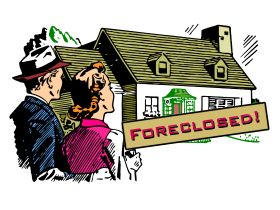
Study reports
worst of US mortgage
crisis still to come

A recent Deutsche Bank report made public last month indicates that the mortgage crisis for US homeowners is still in an early phase, and the worst is still to come. According to the report by analysts Karen Weaver and Ying Shen, by 2011, half of all US mortgage holders will be “underwater,” meaning they will owe more on their homes than they are worth (negative equity). In terms of overall numbers, this translates into 25 million homes.Prime conforming loans, which presently make up two-thirds of all current mortgages, will be most affected by the
The report states that 69 percent of sub-prime
loans will be “underwater” by 2011. Homeowners with adjustable-rate
mortgages or ARMs—whose interest rate is tied
to the prevailing Fed funds rate—are predicted to suffer the greatest
loss of home equity value, with a staggering
89 percent of these homeowners expected to be “underwater” by 2011.
Presently, 77 percent of homeowners with ARMS
have negative equity in their homes.
According to Reuters, areas suffering the worst
negative equity rates are in California, Florida, Arizona, Nevada, Ohio,
Michigan, Illinois, Wisconsin, Massachusetts
and West Virginia. “Las Vegas and parts of Florida and California will
see
90 percent or more of their loans underwater
by 2011,” according to Reuters.
An August 21 article in the Miami Herald, “Florida
foreclosures on rise” by Monica Hatcher, cites Jay Brinkman, chief
economist of the Mortgage Bankers Association,
who states that Florida is presently the worst hit state, with 23 percent
of all home mortgages either past due or in
foreclosure. According to the article, “That figure represents 807,000
loans,
a staggering sum of the roughly 3.5 million
mortgages outstanding in Florida.”
According to Richard Schram of the National
Foundation for Credit Counseling in Silver Springs, Maryland, the
foundation’s 106 member agencies and nearly
850 local offices throughout the country have seen a 1,166 percent
increase in mortgage counseling from 2005
to 2008.
The average yearly income for these homeowners
is $51,243, with an average family size of 3.3 members. Schram notes
that the average monthly negative income of
these clients is $1,286, while their average amount of unsecured credit
debt,
usually credit cards, is $18,625. Job loss
and/or health issues are the main reasons why these homeowners get behind
in
their mortgage payments. Falling income due
to reduced working hours is the second leading cause of mortgage
problems.
A whole new breed of predatory scam artists
has cropped up to prey upon these homeowners in crisis, calling
themselves “mortgage consultants” and offering
“foreclosure services” in an effort to lend their shoddy operations an
aura
of respectability.
One of the most common schemes employed by
these con artists is the “Bait and Switch,” where the homeowner does
not fully understand that he/she is actually
selling his/her home in exchange for a rescue that means nothing.
Another tactic, “The False Intermediary,” forbids
a homeowner from talking to the lender, credit counselor, or anyone
else so that assistance can be sought to negotiate
a way out. Sometimes, homeowners are required to make all mortgage
payments to these “intermediaries,” resulting
in the bank foreclosing on the loan and the scam artist pocketing the alleged
mortgage payments.
The “Rent to Buy” scheme is a method whereby
the homeowner surrenders his home to the illegitimate operator in the
hope that by paying rent he/she will be able
to buy the home over time. The terms of such a buy-back are usually
stacked against the original homeowner, with
the resale value well above market value. Rental fees are often hiked
significantly over time. If the former homeowner
misses a rent payment he/she is evicted and the “rescuing” owner is now
free to sell the home.
The mortgage crisis is directly related and
an integral aspect of the meltdown of the banking system. Although the
liquidity crisis for the American banking
sector began with the massive souring of the sub-prime market, the current
ongoing mortgage crisis is now affecting the
entire range of mortgage lending.
The Two Trillion Dollar Meltdown: Easy Money,
High Rollers, and the Great Credit Crash by Charles R. Morris,
published in 2008, gives some idea of the
amount of bad home mortgage loans presently on the books of US banks.
Since according to Federal Reserve banking
requirements banks can lend out $10 for every one-dollar booked as an
asset, which is what a performing mortgage
loan can be considered, the amount of money effectively being drained from
the US economy would be $20 trillion.
What this has in fact meant is that banks can
no longer make the kinds of essential loans that are necessary in order
for
businesses to expand, increase inventories
and increase employment to match population growth and market demand for
product and services.
The crisis in banking and finance is compounded
by the fact that so many different types of loan products were “sliced
and diced” into exotic derivative investment
instruments designed and sold to other major financial institutions as
a sound
high yield investment. This also served as
a way of leveraging the risk incurred by the banks that were engaging in
shady
and duplicitous lending practices.
Such practices were designed to maximize their
corporate growth potential in an industry where the very survival of any
particular bank was directly related to its
ability to grow and take over less well performing, i.e., slower growing
financial
institutions.
The government essentially covered the bad
gambling debts of the banks and big financial houses. The handover of
trillions in public assets to the banks shored
up their bottom lines and accelerated the monopolization of the finance
industry in the hands of a few mega-banks.
At the same time it has done nothing to provide relief to tens of millions
of
homeowners facing the loss of their houses.
By Charles Knause 10 September 2009 Alternet news, online. Subscribe,
It comes daily, free.
<===BACK TO THE FUTURE INDEX PAGE